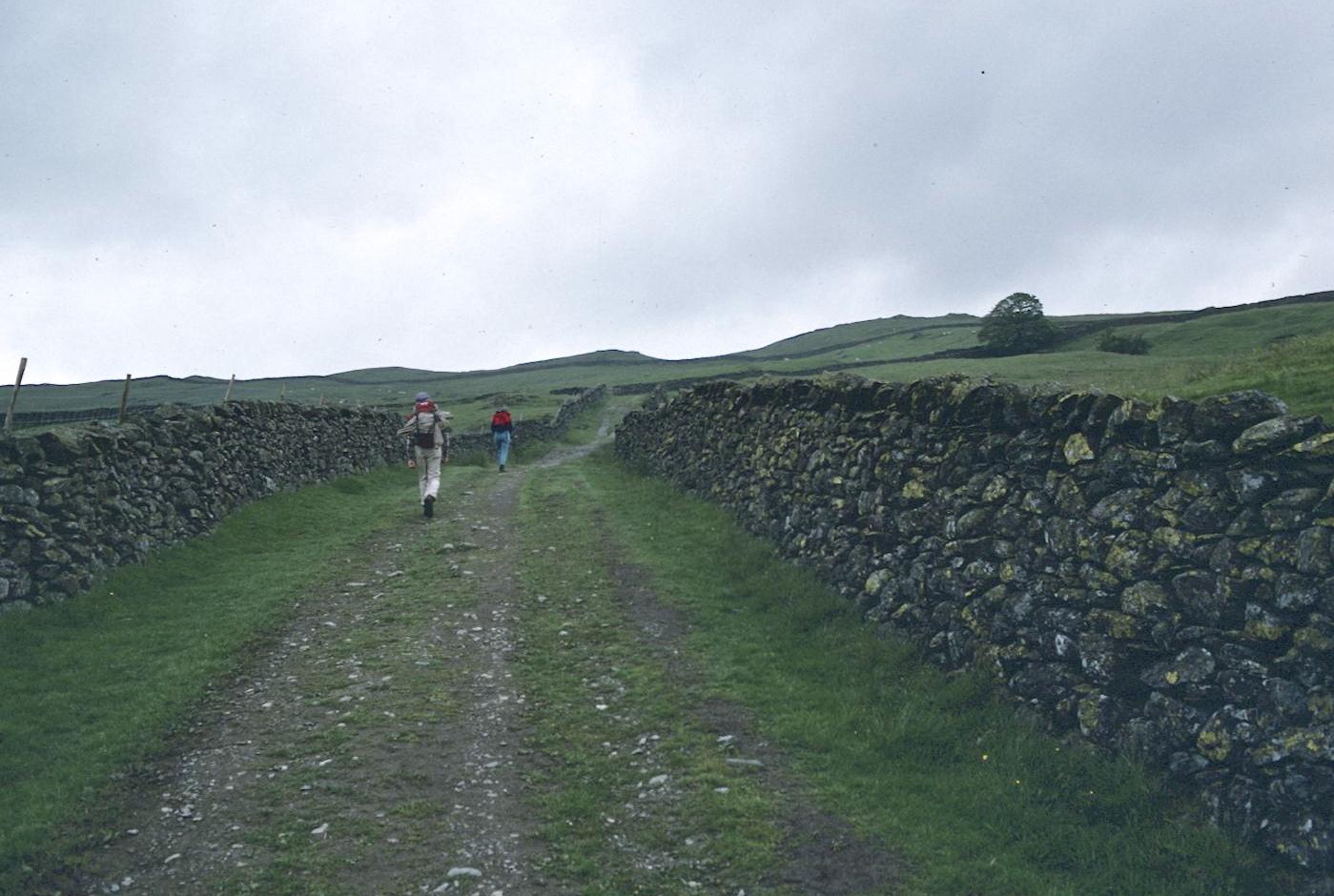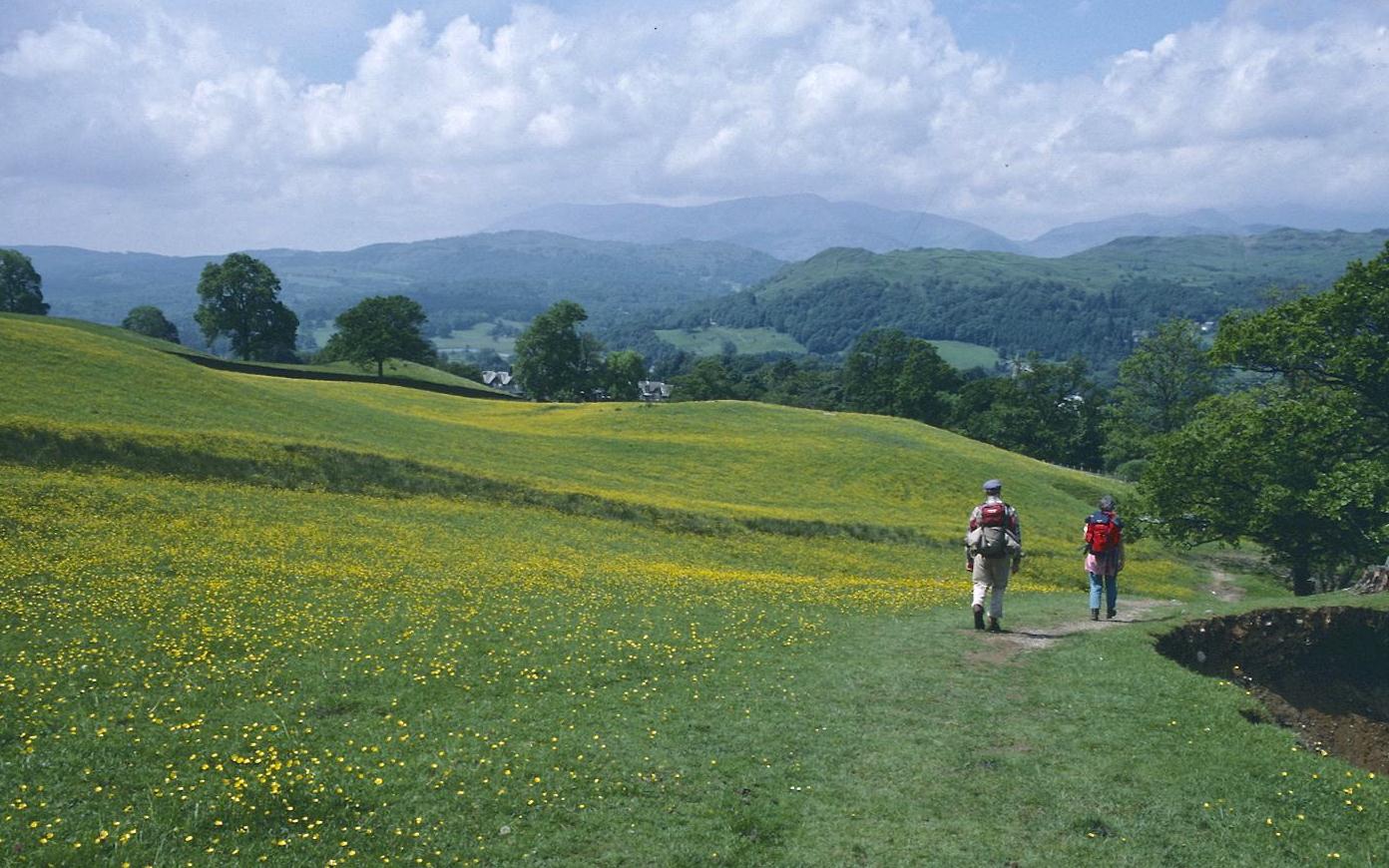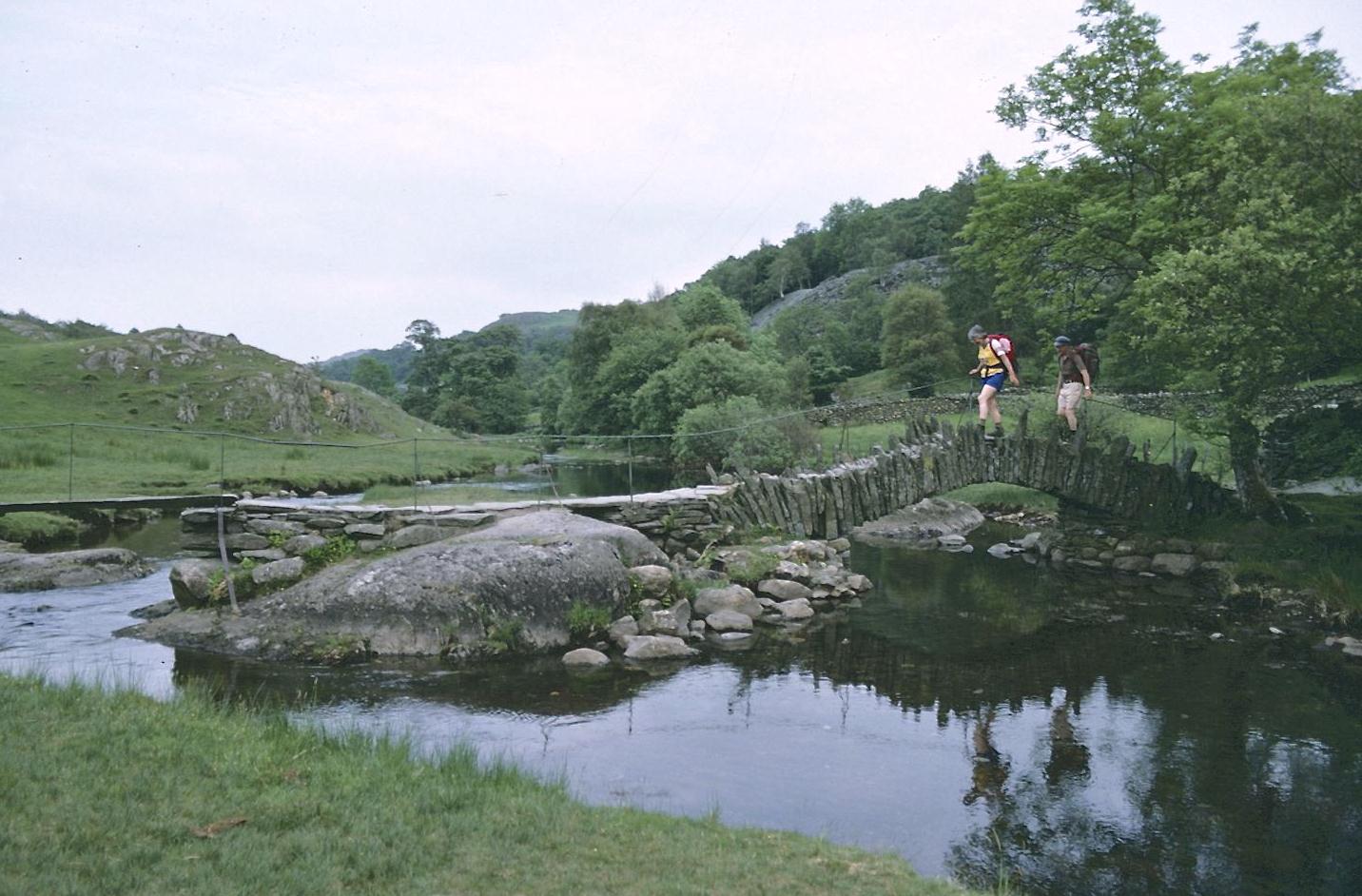June 25, 1986: Troutbeck to Little Langdale
I had considerable difficulty getting to sleep – every bone in my body was sore from the previous day’s exertions and those parts not sore were blistered. Curiously, however, I had suffered no problems from the sacroiliac pain that had been plaguing me for a week in London. The pack actually seemed to have helped – that and the pleasure of being in such lovely countryside.
As our third day on the Roman Way dawned I took the damp wadding out of my boots – but I didn’t have the courage to put them on yet. I went to breakfast in my Adidas therefore – happy to discover that the stench of chip oil had cleared. We ate at a leisurely pace, recovered our gear, put on our boots and paid up – my accommodation had been incredibly cheap considering its quality.
It was grey, with a drop or two of moisture, as we left at 10:10, but there were bright patches in the cloud as well. We headed north on one tarmac lane, then south at a sharp angle to reach the High Green section of Troutbeck. I paused to mail the daily postcard to Jay. Harold wanted to put on his raingear, but I suggested we wait and see. Tosh was enchanted by Troutbeck, its setting and prospect and by all the flowers – in gardens, growing out of walls. We paused to view the village opposite a pub sign for the Mortal Man (where we also stayed many years later). As we began our ascent of Nanny Lane an old man waved from his back yard. “Is it going to rain?” he asked us. “You’re the expert,” I replied. Tosh added, “It rains every day, doesn’t it?” To which the old man replied, “Every other day.”
The walled lane that we were steadily climbing reminded me of similar roads in the Pennines. It was fun to follow the twists and turns of this one and to hunt for our turnoff onto open moorland. Once this point was reached we could begin to see our route as it climbed the only summit of the day, Wansfell Pike. Tosh seemed discomfited by the steep ascent, but I assured her that it would not be too difficult or arduous and that we would make it easily. Nevertheless she had to pause several times to shed clothes or put on her shorts or pee. She and Harold were forever stopping on some such mission on this day and the only time I ever had them both in my sites at the same time was on descents – when they liked to adopt a much faster pace than my toes could stand.
The higher we climbed on Wansfell Pike, following tracks and cairns in clearly marked territory, the more glorious the view became. The threat of rain had lifted completely and Windermere was stretched out before us in a dramatic setting of grey and blue. I reached the top first, followed by Harold. It was a grand prospect, through quite windy up here. We therefore pushed on to begin the descent to the northwest, a very steep plunge down the hillside on an eroded track clogged with trippers struggling up from Ambleside and wanting to know how much farther they had to go. To those close to the top we replied, “Only a short way to go.” To those behind them we replied evasively, “Well worth the effort.”
Ambleside itself and the whole central Lakeland valley was now shining below us in sudden warm sunshine. It seemed to take forever to reach the foot of Wansfell Pike – we were happy to have climbed this peak from the other side, which is far gentler. Tosh and Harold were well below me as I continued to cut the widest of switchbacks in order to avoid undue pressure on the toes. At the lower levels we were joined by a beck on our right and fields of buttercups on our left. Just before we left our track to descend on a tarmac road to Ambleside, Tosh paused before a one-room shed. “I wonder what this is?” she asked. “It’s a well,” someone inside the shack answered.
On the road to Ambleside there was an entrance to the grounds of Stockghyll Force. We took this detour and climbed back up to see the waterfall. An inviting path descended at the side of the stream, but I was uncertain about the exit at the bottom and so we returned to the road, which passed a girls college and plunged into suburban Ambleside. A footpath took us behind houses, with a Sheltie giving us a good scolding from his back yard. We had to guess which streets to follow to get to Lake Road, but after several more lovely gardens we reached the main highway and turned north, passing Wearing’s Book Shop and entering a newsagent. Here we bought soft drinks, candy, and newspapers. The latter were meant to replace those that had soaked up the boot moisture encountered on High Street. Tosh was interested in the political soundness of the papers we bought. I just wanted the thickest.
One of the great advantages of this middle day of our walk, coming as it did after the efforts of the previous day, was that the easy nine miles could include both a pub and a tea stop. We were now searching for the former and chose the White Lion because there was an outdoor table we could squeeze into – though Tosh complained about the proximity to motorcars. We each had a pint of lager and ordered our food – sandwiches for me and Harold, leek and stilton soup for Tosh. He disappeared to buy a pullover while we were waiting for the food. After we had finished our lunch she disappeared to buy some gooey pastries for us.
At the next table were some visiting South Africans. She was an attractive middle-aged blonde woman who spent all of her time discussing the prices of articles of clothing. When her husband protested that she was paying too much for a pair or riding breeches she argued that it was okay because she had no intention of wearing them for riding. They were accompanied by a patient English couple who probably didn’t want to hear about last year’s interprovincials in Randsburg. When they were gone Tosh again bewailed the fact that we didn’t have Dorothy for instant style analysis.
We left Ambleside about 2:00 and headed west on a side street. My rain cape, which I had stuffed behind my knapsack straps, worked its way loose here, but it was picked up and returned to me by a kindly Amblesider. It seemed strange to be walking on pavement after the uncertain surfaces of the last few days. Seduced by sidewalk, however, I failed to note that we had missed our turnoff to Clappersgate. It would have been even more of a backtrack if Harold hadn’t asked what body of water we were now approaching. Clearly the extensive sheet before us was Windermere, not the River Brathay. I turned us around, crossed the street, rounded the rugby club, passed a swish hotel, steered a perilous course over a traffic-clogged hump back bridge and we were at last heading west again – with our own walk now along the side of the busy Coniston Road.
It was quite warm and the sun was beating down on us. Tosh paused to adjust her pack and Harold and I pressed on without her to the Old Brathay turnoff. Here he waited for her while I crossed the Clappersgate Bridge alone. I sat on a stone abutment waiting for them to appear, but only Tosh arrived –Harold having stayed behind to adjust his pack. Harold then appeared but Tosh decided to put on her shorts behind the entrance wall of the hotel across the street. When we had resumed our road walking on the south side of the river and cleared Clappersgate church Harold decided to put on his shorts so Tosh and I continued for a while, then waited in a shady spot for him to catch up. He did so eventually but then he had to go through his pack to make sure he had left nothing behind while changing! It was a good thing we were having a lazy day, though I was getting cross with all the interruptions.
We climbed the hill to Skelwith Fold, a lovely little hamlet full of wonderful flowers, then followed the road downhill to Skelwith Bridge. Here Tosh and I were revisiting a section of the 1984 Alternatives route, including a stop at the cafeteria of the Kirkstone Slate Company showroom and gift shop. We selected an outside table (since knapsacks, dogs, and prams were unwanted inside) and had something cool to drink. I took my boots off and let my sweat-dampened socks absorb some of the cool from the slate flooring. I left footprints whenever I put a sock down on this surface. When it was time to go I gave Harold a brief tour of the slate kitsch showroom. Harold was himself an odd spectacle now, with his thin bare legs peeping out of shorts that had been made by cutting the legs of a pair of trousers. This he had done only a few inches above the knee, but he hadn’t hemmed the new length and the cuffs were beginning to unravel.
We re-crossed the bridge and headed up the Coniston Road. I put us briefly on the footpath to Skelwith Force, but this was not what I was looking for. We had to retrace our steps to the road, turn right and continue on just a few more yards to find the turnoff for the Colwith Force footpath. This was easy for us to follow because we were back in territory familiar to us from our walk on the Cumbria Way. Naturally I was interested in seeing why I had missed this stretch in October, 1984. In fact waymarking remained a bit obscure for the novice, though the general westerly trend was obvious. This stretch seemed far more urbanized now. We passed a row of caravans. One dweller therein was outside his home testing the correct direction for the TV antenna he was holding in one hand – with the thwack of tennis balls at Wimbledon echoing from inside. At another spot on this stretch the telephone company was stringing a wire over the footpath. Harold was amazed at my memory for detail – my predicting a bed and breakfast sign in the window at Park House, for instance. Walking conditions could not have been in greater contrast to those of two years earlier. Then we had been lashed by rain. Now we were being slowly broiled in the hot sun.
After the descent to the riverside we crossed a field and climbed over a stile to the road just south of Colwith Bridge. We walked up to the bridge and then retraced our steps to the beginning of the High Park route. We rested for a bit on the first hillside and shared a 7-up. I did some scouting and found a good riverside path for us to follow to Colwith Force. Tosh and I had been along here in 1984, but we wanted Harold to see it. The last of the bluebells were still blooming.
For a while I thought we would never find the diagonal ascending path to High Park, though I remembered it coming in behind us in 1984. We had followed the river for some distance above the force when at last it appeared. The climb was not too steep and eventually it put us out in High Park Farm’s back yard. I had missed this turnoff too, but it still did not seem easy to follow from the west, which had been our position last time.
We escaped the farmyard and continued on a track to Stag End, walking mostly in the shadow now. At this second farmhouse there were several choices, one uphill on tarmac, and one on footpath across the river – both wrong for we had to continue on tarmac to the west. As the road curved south at the next bottom I chose the footpath to the right. This soon brought us back to the shallow Brathay. At its next bridge we witnessed an unusual sight. Instead of using the bridge to cross the river some adults were leading a large group of handholding children across the water calf deep in the river, boots and all! “This looks like a scene from Seventh Seal,” I said.
We too disdained this bridge to follow the river some more, crossing finally at the delightful Slater Bridge, a wonderful homemade stone arch, and proceeding in a northwesterly direction on a grassy route below some rocks to reach a minor lane to Little Langdale. I could see our destination, the Three Shires Inn, some distance away. It was 6:05. As Tosh and Harold wanted the room with twin beds I took the one with the double bed in a little cottage, recently renovated by the Inn, back on the minor lane. I was given a key to the building and to my upstairs room and retraced my footsteps in order to let myself in. I had a bath and at 7:00 returned to the main building to down a pint of lager. I was very hot and uncomfortable in my blue turtleneck, but I hadn’t brought anything cooler.
We ordered from an extensive menu – with Harold and I starting off with noodles in garlic. He and Tosh then had the salmon and I the veal. The Lees ordered a bottle of wine to celebrate my forthcoming 1000th mile, which I would reach in August. Tosh and I talked English department curriculum until we were too giddy to concentrate. There were sumptuous desserts. The Three Shires Inn was famous for its food and we were well satisfied. We had coffee in the lounge and the Lees then walked me back to my cottage and we all had an early night.
To continue with the next stage of our walk you need:



